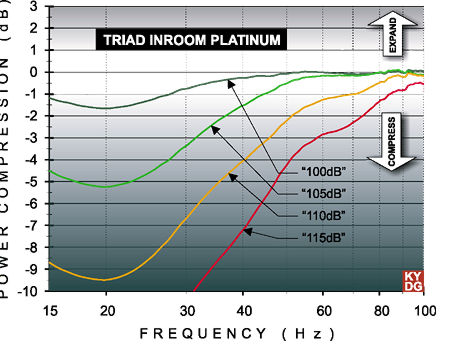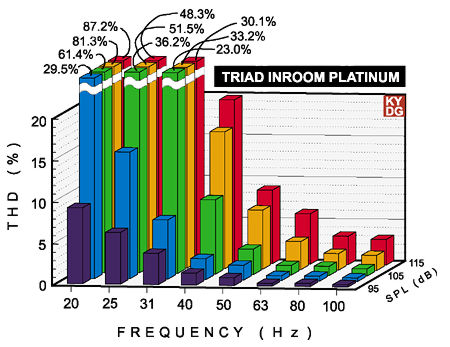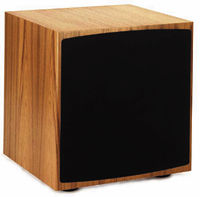Way Down Deep III Triad Inroom Platinum
Annual surveys of CEDIA-type AV dealers reveal Triad to be one of the industry's most admired brands, with a reputation for no-BS engineering, predictably excellent sound quality, and unfailingly good value. The InRoom Platinum is the Oregon company's flagship subwoofer, featuring a front-firing 18-inch driver in a sealed box and an outboard electronics package that can be mounted in a rack. In addition to Level and continuously variable Phase controls, the front panel for the crossover and power amp sports two controls for setting lowpass filter frequencies. Each is a 12dB/octave affair, and they're arranged in parallel so the user—or, more likely, the installer—has more flexibility in getting a good blend with the main speakers.
Measurements
Frequency response at 80dB (Fig.10): 20–100Hz, +/-1.0dB; –3.1dB at 18Hz.
Frequency response at higher levels (Fig.10): The deep-bass response started to droop at the 105dB playback level. The smooth nature of the low-frequency rolloff suggests that system response is electronically managed at the higher playback levels to prevent driver overload.

Fig.10: Frequency Response vs. Output
Dynamic range: At 100dB, the Triad exhibited some power compression at very low frequencies (Fig.11). This increased significantly at higher levels. Among the dozen subs in the survey, the Triad proved to be a middle-to-back-of-the-pack performer in terms of maximum output before audible distortion set in (Fig.12).

Fig.11: Power Compression

Fig.12: Shaped Tone-burst Peak Output
Total harmonic distortion (Fig.13): Distortion follows the familiar pattern of rising as the frequency decreases and the playback level increases, but THD levels are relatively high across the board at high levels below 50Hz. Vertical bars above 20% in Fig.13 can be cause for concern, though the audibility of bass distortion depends on factors—e.g., the presence of masking content in the source signal, which harmonic is distorting, at what level, etc.—beyond the scope of this article.

Fig.13: Total Harmonic Distortion vs. Frequency & Level
Listening
Telarc's "Jurassic Lunch" is little more than crass show-off material, but it's the state of that genre's art. The T. rex's stentorian roar, the squeal of his prey, the crunch of bones in the beast's bloody maw, the grisly masticating—it's all meant to terrorize any human or animal within earshot. The beast swallows the last chunk, indulges in a fetid, Technicolor belch, and lurches off heavily into the leafy dark. That final ground-shaking clomp at 1:02 is more than just the exclamation point in a string of over-the-top sound effects; it's what tells the listener it's safe to come out from behind the sofa.
 The InRoom Platinum turned the clomp into a clean little thud peaking at 101dB. Like the CoDrive CB1 tested for this installment, it captured the portion of the clomp's spectrum above about 22Hz and missed the rest (Fig.A4). As the reference spectrogram shows (Fig.A1), the recorded energy on the CD is strong down to 10Hz. Doing level-matched A/B comparisons with the best performer on this track, the big ServoDrive unit tested in Part II, left no doubt that making the air throb and the ground shake depends on a sub's ability to plumb the 16–22Hz range, something precious few subs of any size can manage.
The InRoom Platinum turned the clomp into a clean little thud peaking at 101dB. Like the CoDrive CB1 tested for this installment, it captured the portion of the clomp's spectrum above about 22Hz and missed the rest (Fig.A4). As the reference spectrogram shows (Fig.A1), the recorded energy on the CD is strong down to 10Hz. Doing level-matched A/B comparisons with the best performer on this track, the big ServoDrive unit tested in Part II, left no doubt that making the air throb and the ground shake depends on a sub's ability to plumb the 16–22Hz range, something precious few subs of any size can manage.
The Platinum did a more credible job with the U-571 depth charges, which showed a compelling if less than teeth-rattling concussiveness up to a peak level of 107dB (Fig.B4). It got through Pearl Harbor's Gooding-at-the-guns passage at the same level (Fig.D4) without blunting individual gun discharges or adding a flapping/thwocking quality, a reasonably impressive achievement for a unit of this size and price. The Triad wasn't as convincing in the "F'ing Irene," fire-up-the-choppers scene in Black Hawk Down (Fig.C4), where its inability to pull the sustained 18Hz rumble into play diminished the scene's emotional power.
In none of these four core movie clips did the Triad's highish measured distortion draw attention to itself; in fact, the unit steadfastly refused to honk, rattle, rasp, or otherwise let on that my torture tracks were discomfiting it. Rather than issue distress cries, it simply stopped getting louder as I slowly turned up the level.
You might expect that the next track, "March of the Exorcists," from the Casper soundtrack CD, would've been easier going; after all, my test passage contains just four well-separated bass-drum strokes. They're ocean-deep as bass-drum strokes go (the root energy is around 40Hz, nearly an octave lower than bass drums heard in typical pop, rock, and jazz recordings), but full of subtlety, with a long reverberant tail that's wonderfully exposed—a long way from the wind-up-and-whack-it school of percussion playing.
Beginning at the –10 volume setting on my Lexicon MC12B pre-pro, the InRoom Platinum wrapped a gauzy layer of distortion around each stroke. That layer thickened each time I raised the volume another decibel. At –5, the fuzz was joined by incipient compression; i.e., beyond this volume setting, each additional decibel of drive produced significantly less than 1dB more output from the sub.
I disconnected the Platinum, reconnected the main speakers, and adjusted the volume until I found the level I preferred for normal foreground listening on this track, which turned out to be –3 on the Lexicon. If you do the math, you'll see that it would take two or three InRoom Platinums to get through this track distortion-free at my preferred playback level. (Remember, these tests were run outdoors. All other things being equal, SPL levels will be higher indoors—and thus distortion lower for a given sound level—because of reinforcement by the room's walls and ceiling.)
The Triad's contributions to the helicopter landing scene about 26 minutes into Apocalypse Now Redux were free of audible distortion, but per my session notes, the overall presentation came up just short of fully believable: the video showed "chopper blades blowing dust everywhere, but there wasn't enough dirt-rumble for the auditory cues to fully match the visuals." Topping out at 106dB, the sub wouldn't play loud or deep enough on the Blue Crush passage to create as immersive and threatening an effect as many of the other subs in the survey.
The final cannon blast of Tchaikovsky's 1812 Overture sounded crisp and balanced up to 104.5dB, but leaving the level there and reconnecting the main speakers was a disappointment due to a mismatch between how loud the system was playing and how loud the recording suggested it should be played. (There's a "right" level to play back most recordings, based on instrumental timbre, but that's beyond our scope here.)
The famous bass-drum whack that gets Holst's First Suite off to its jaunty start was clean up to a sub-only peak of 98.5dB. That sounds like a lot. It isn't. Reconnecting the main speakers and starting the piece over, with no change to the volume knob, got me to the level you might use for showing your system to Aunt Mabel while sipping tea. Note that we're talking instantaneous peak levels here; the more familiar average levels will typically measure 10–15dB below the peaks, depending on meter ballistics and program material.
The Triad fared better with The Matrix, where the chopper explosion seemed to lack nothing. The bass-drum sock in Béla Fleck's "Flight of the Cosmic Hippo" was clean and well-defined, but took on the same fuzz at higher playback levels as I heard with the Casper soundtrack.
The Bottom Line
Compared to dozens of subwoofers now on the market in roughly its size and price ranges, the Triad is comfortably near the front of the pack. It goes reasonably deep and reasonably loud, and at low enough distortion to earn it a spot on the critical listener's should-hear list. But if you've spent much time around Triad products, you might find it hard to shake the sense that the InRoom Platinum is a solid but essentially undistinguished effort. Given its provenance, that makes the 'Plat vaguely disappointing. Consider it the Curse of the Highly Esteemed: It's expected that every product you turn out will be not just really good but something special.
Specifications
Triad InRoom Platinum PowerSub subwoofer in sealed cabinet with outboard power amplifier
Driver: 18" coated-paper cone with cast basket
Frequency response: 20–180Hz, +/-3dB
Inputs: Unbalanced line-level (RCA), speaker-level (5-way binding posts
Outputs: 5-way binding posts (amplifier)
Amplifier: 500W, outboard, rack-mountable
Highpass filter: 100Hz, 12dB/octave
Lowpass filter: adjustable via two 12dB/octave controls, 35–250Hz
Phase: adjustable, 0–180°
Other: THX Ultra certification (optional)
Finishes: black, white, custom-color paint; natural oak, seven other standard wood veneers; rosewood, bird's-eye maple, eight other premium wood veneers
Dimensions: 20.4" x 19.6" x 17.5" (HxWxD)
Weight: subwoofer, 87 lbs; amplifier, 20 lbs
Price: $2600
Triad Speakers
(800) 666-6316
www.TriadSpeakers.com




























































